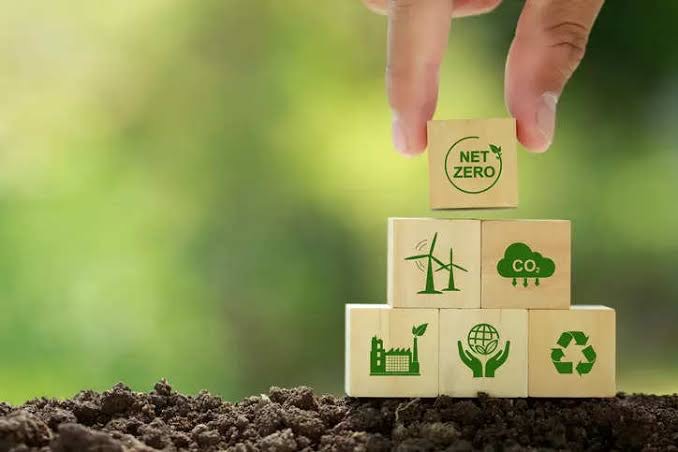With carbon emissions linked to human activities (such as illegal logging, transportation, and burning of fossil fuel – coal, oil, and natural gas – to make electricity and heat etc.) not seeing a drastic decline anytime soon, the world is no doubt in for a difficult deal because greenhouse gasses produced by these carbon emissions trap heat and in turn make the planet warmer. Studies have found that carbon dioxide (CO2), methane (CH4) and nitrous oxide (N2O) are some of the greenhouse gasses that are found in the atmosphere. The influence of human activities in the production and emission of more carbon makes climate change anthropogenic in nature.
According to the International Energy Agency (IEA), global energy-related CO2 emissions grew by 0.9% or 321 metric tonnes in 2022, a development that forced the total global emission to reach a new high of over 36.8GT, the world continues to watch itself to see the on-the-ground implementation of the nationally determined contributions (NDC) – country-set targets for mitigating the GHG emissions that cause climate change and for adapting to climate impacts – as well as the Paris Agreement which was adopted by 196 countries at COP21 in Paris in 2015.
Carbon Brief, while citing data from the Climate Analysis Indicators Tool (CAIT) database maintained by the World Resources Institute (WRI), which includes emissions from land use, land-use change and forestry (LULUCF), noted that Nigeria’s annual greenhouse gas emissions were 345.7m tonnes of CO2 equivalent (MtCO2e) in 2018. This did not come as a surprise as the country operates on an oil-dependent economy while an estimated 3.7% of its forest is lost every year, according to the United Nations among other staggering data in the fight against climate change.
In its review and update of Nigeria’s NDCs in July 2021, the federal government said it is committed to achieving a 20% reduction of greenhouse gasses emission target by 2030 as pledged under the 2015 NDC and with support from the international community, it is committed to reducing emissions by 47% below BAU (business-as-usual) levels by the same year. A report further estimates that the commitment is equivalent to an emissions level 1% above to 23% below 2010 levels excluding land use, land-use change and forestry (LULUCF) by 2030.
A few months after updating this policy framework, President Muhammadu Buhari, on October 18, 2021, signed a landmark legislation called the Climate Change Act which commits public and private entities within the country to strive to reach net-zero emissions by 2060. The Act also established the National Council on Climate Change which is now headed by Salisu Mohammed Dahiru as its Director General. Stakeholders also believe the Act further gave the commitments under the NDCs legal backing in the country.
Beyond Nigeria, there have been concerted efforts by various corporations and countries of the world to stem the tide of climate change. In the numerous discussions aimed at understanding the idea of climate change at many fora, stakeholders brandy specific terminologies, such as carbon emission, carbon footprint, carbon accounting, carbon offset, carbon capture, carbon credit and carbon market that help them to understand the minutest concepts of climate change easily and propels the conversations surrounding climate change forward. These jargons, however, may seem too much for the layman to understand as such there is the need to provide succinct explanations.
Carbon Emission refers to the byproducts of the combustion of natural gas and petroleum products for various purposes including heating, cooking, manufacturing of cement, and transportation as well as gas flaring. These greenhouse gasses released in the atmosphere as byproducts of these combustions include carbon dioxide (CO2), methane (CH4), and nitrous oxide (N2O). According to the US Environmental Protection Agency (EPA), emissions from natural gas consumption represent 80% of the direct fossil fuel CO2 emissions from the residential and commercial sectors in 2021.
Carbon Footprint is the total amount of greenhouse gasses (including carbon dioxide and methane) which are relevant to climate change and are generated by human actions/activities such as food production, consumption, and wastage, transportation, and household energy use from coal, natural gas, and oil i.e. fossil fuel. Experts charged all to be worried because the more greenhouse gasses we produce from these aforementioned activities and others, the warmer the earth becomes.
Carbon Accounting refers to the process of measuring the overall amount of greenhouse gasses (GHGs) produced directly and indirectly from the activities of a business or corporate entity. This process not only provides necessary insights to quantify and measure an entity’s carbon emissions but it also assists in making informed decisions when it comes to carbon and mitigation strategies.
Carbon Capture and Storage: Activities aimed at removing and sequestering CO2, methane and other GHG from the manufacturing and power plants for specific treatment and transportation to a long-term storage location. Though described as simpler to deal with, methane is 20 times more harmful to the environment than CO2 and can be burned off directly at the source to create CO2. Carbon Credits explains that while this sounds counterproductive initially, converting one molecule of methane to one molecule of CO2 through combustion still reduces net emissions by more than 95%.
Carbon Offset can represent greenhouse gas removal. It can broadly refer to an increase in carbon storage (e.g., through land restoration or the planting of trees) that is used to compensate for emissions that occur elsewhere. For example, reforestation and conservation are being used to offset carbon emissions in other parts of a country and the world to absorb carbon dioxide. The same thing goes for waste and landfill management as well as renewable energy such as hydro, wind and solar projects which help to reduce the dependence on other energy sources.
Carbon Credit generally represents a reduction in greenhouse gas emissions whereby a government limits the carbon emissions that specific industries can release. On the flip side, if a project can quantifiably and repeatedly produce less GHG than the current alternative, it will be eligible to earn carbon credits.
Meanwhile, both carbon offset and credit are sometimes used interchangeably to refer to a transferrable instrument certified by governments or independent certification bodies to represent an emission reduction of one metric ton of CO2, or an equivalent amount of other GHGs.
Carbon Market refers to the regulated and voluntary meeting place where both carbon credits and carbon offsets can be traded simultaneously by investors and corporations. In the mandated or regulatory market, regions and states are the participants while the voluntary market is where businesses and individuals can buy carbon credits to offset their own carbon emissions.
What experts say about carbon emission
UK-Based Renewable Energy Consultant and Data Analyst, David Ahonsu, while speaking on a recent climate change podcast charged the people to not only determine their carbon footprints but also to reduce their direct and indirect emissions of CO2 and other GHG.
“Except we look at it as a way of gradually transitioning from the use of fossil fuel to renewable energy sources, that’s when carbon offset and credit can be a good idea to pursue,” Ahonsu said.
He further urged governments to boost natural efforts to remove carbon emissions from the atmosphere including coastal blue carbon which involves enhancing the growth of aquatic plants to absolve CO2 from the atmosphere while listing other efforts to include afforestation, reforestation, and improved forest management.
He also urged entities to be accountable for their carbon footprint by acknowledging the rate of emissions, disclosing them in environmental reports, mitigating their carbon emission via removal or reduction as well as ensuring that accurate information is released to the public about their activities.
Also speaking on how to reduce human activities that contribute to climate change, an environmentalist and Executive Director of Neighbourhood Environment Watch Foundation (NEWF), Dr Kelechukwu Okezie, called for urgent and ambitious action through the strengthening of existing extant environmental laws to stem the tide of the current deforestation because of its dangerous effects on the environment.
“Deforestation is not only causing climate change, but climate change is also contributing to further deforestation and forest degradation, setting in motion a vicious cycle with devastating effects.
WATCH TOP VIDEOS FROM NIGERIAN TRIBUNE TV
- Relationship Hangout: Public vs Private Proposals – Which Truly Wins in Love?
- “No” Is a Complete Sentence: Why You Should Stop Feeling Guilty
- Relationship Hangout: Friendship Talk 2025 – How to Be a Good Friend & Big Questions on Friendship
- Police Overpower Armed Robbers in Ibadan After Fierce Struggle






